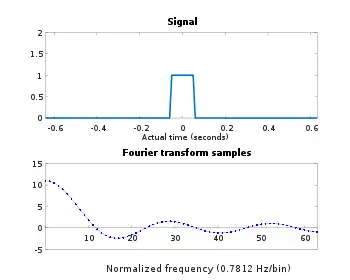In digital signal processing (DSP), a normalized frequency is a ratio of a variable frequency () and a constant frequency associated with a system (such as a sampling rate, ). Some software applications require normalized inputs and produce normalized outputs, which can be re-scaled to physical units when necessary. Mathematical derivations are usually done in normalized units, relevant to a wide range of applications.
Examples of normalization
A typical choice of characteristic frequency is the sampling rate () that is used to create the digital signal from a continuous one. The normalized quantity, has the unit cycle per sample regardless of whether the original signal is a function of time or distance. For example, when is expressed in Hz (cycles per second), is expressed in samples per second.[1]
Some programs (such as MATLAB toolboxes) that design filters with real-valued coefficients prefer the Nyquist frequency as the frequency reference, which changes the numeric range that represents frequencies of interest from cycle/sample to half-cycle/sample. Therefore, the normalized frequency unit is important when converting normalized results into physical units.

A common practice is to sample the frequency spectrum of the sampled data at frequency intervals of for some arbitrary integer (see § Sampling the DTFT). The samples (sometimes called frequency bins) are numbered consecutively, corresponding to a frequency normalization by [2]: p.56 eq.(16) The normalized Nyquist frequency is with the unit 1/Nth cycle/sample.
Angular frequency, denoted by and with the unit radians per second, can be similarly normalized. When is normalized with reference to the sampling rate as the normalized Nyquist angular frequency is π radians/sample.
The following table shows examples of normalized frequency for kHz, samples/second (often denoted by 44.1 kHz), and 4 normalization conventions:
| Quantity | Numeric range | Calculation | Reverse |
|---|---|---|---|
| [0, 1/2] cycle/sample | 1000 / 44100 = 0.02268 | ||
| [0, 1] half-cycle/sample | 1000 / 22050 = 0.04535 | ||
| [0, N/2] bins | 1000 × N / 44100 = 0.02268 N | ||
| [0, π] radians/sample | 1000 × 2π / 44100 = 0.14250 |
See also
References
- ↑ Carlson, Gordon E. (1992). Signal and Linear System Analysis. Boston, MA: ©Houghton Mifflin Co. pp. 469, 490. ISBN 8170232384.
- ↑ Harris, Fredric J. (Jan 1978). "On the use of Windows for Harmonic Analysis with the Discrete Fourier Transform" (PDF). Proceedings of the IEEE. 66 (1): 51–83. Bibcode:1978IEEEP..66...51H. CiteSeerX 10.1.1.649.9880. doi:10.1109/PROC.1978.10837. S2CID 426548.